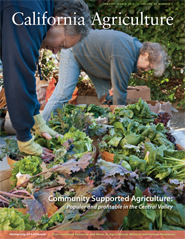All Issues

Community Supported Agriculture:
Popular and profitable in the Central Valley
Cover:
The popularity of Community
Supported Agriculture (CSA), farms that
deliver fresh produce to members, has
been increasing rapidly. In a survey,
54% of CSA farmers in the Central
Valley and surrounding foothills were
pro fitable, with average gross sales
per acre of $9,084 (see page 8). At Live
Power Community Farm CSA, longtime
members Sean Cotter (left) and
Robin Chandler volunteer to sort winter
produce, which they then deliver to
members in their neighborhoods.
Photo: Nancy Warner
January-March 2012
Volume 66, Number 1
Volume 66, Number 1





